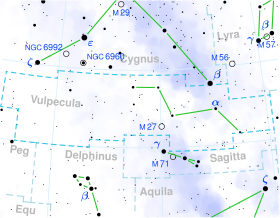Star in the constellation Vulpecula
9 Vulpeculae
Observation dataEpoch J2000 Equinox J2000
Constellation
Vulpecula
Right ascension
19 34 34.89705
Declination
19° 46′ 24.2423″
Apparent magnitude (V)
5.010±0.009 (4.99 - 5.08)
Characteristics
Spectral type
B8 IIIn
Apparent magnitude (U)
4.499±0.012
Apparent magnitude (B)
4.906±0.011
Variable type
suspected
Astrometry Radial velocity (Rv )+5.00 km/s Proper motion (μ) RA: +13.148 mas /yr Dec.: +5.142 mas /yr Parallax (π)5.8317 ± 0.1242 mas Distance 560 ± 10 ly pc ) Absolute magnitude (MV )−1.14 Details Mass 3.5 M ☉ Radius 2.8 R ☉ Luminosity 216 L ☉ Surface gravity (log g )3,54 cgs Temperature 12,042 K Metallicity −0.03 dex Rotational velocity (v sin i )185 km/s Age 185 Myr Other designations 9 Vul , NSV 12173, BD +19°4063, GC 27047, HD 184606, HIP 96275, HR 7437, SAO 104990, WDS J19346+1946A Database references SIMBAD data
9 Vulpeculae is a star in the northern constellation of Vulpecula , located about 560 light years away based on parallax . It is visible to the naked eye as a faint, blue-white hued star with a baseline apparent visual magnitude of 5.01. The star is moving further from the Earth with a heliocentric radial velocity of +5 km/s.
This a B-type star with a stellar classification of B8 IIIn, where the 'n' notation indicates "nebulous" lines due to rapid rotation. It has a high rate of spin with a projected rotational velocity of 185 km/s. The star is radiating 216 times the Sun's luminosity from its photosphere at an effective temperature of 12,042 K . This is a suspected variable star of unknown type, ranging in magnitude from 4.99 down to 5.08.
9 Vulpeculae has two reported companions: component B, with a separation of 9.3" and magnitude 13.4, and C, with a separation of 108" and a magnitude of 12.5". Both are unrelated background objects.
References
^ Vallenari, A.; et al. (Gaia collaboration) (2023). "Gaia Data Release 3. Summary of the content and survey properties" . Astronomy and Astrophysics . 674 : A1. arXiv :2208.00211 . Bibcode :2023A&A...674A...1G . doi :10.1051/0004-6361/202243940 . S2CID 244398875 .
Gaia DR3 record for this source at VizieR .
^ Harmanec, P.; et al. (2020). "A new study of the spectroscopic binary 7 Vul with a Be star primary". Astronomy and Astrophysics . 639 . Table A.1. arXiv :2005.11089 . Bibcode :2020A&A...639A..32H . doi :10.1051/0004-6361/202037964 . S2CID 218862853 .
^ Samus, N. N.; Durlevich, O. V.; et al. (2009). "VizieR Online Data Catalog: General Catalogue of Variable Stars (Samus+ 2007-2013)". VizieR On-line Data Catalog: B/GCVS. Originally Published in: 2009yCat....102025S . 1 . Bibcode :2009yCat....102025S .
^ Mason, Brian D.; Wycoff, Gary L.; Hartkopf, William I.; Douglass, Geoffrey G.; Worley, Charles E. (2001). "The 2001 US Naval Observatory Double Star CD-ROM. I. The Washington Double Star Catalog" . The Astronomical Journal . 122 (6): 3466. Bibcode :2001AJ....122.3466M . doi :10.1086/323920 . Vizier catalog entry
Gontcharov, G. A. (2006). "Pulkovo Compilation of Radial Velocities for 35 495 Hipparcos stars in a common system". Astronomy Letters . 32 (11): 759–771. arXiv :1606.08053 . Bibcode :2006AstL...32..759G . doi :10.1134/S1063773706110065 . S2CID 119231169 .
Anderson, E.; Francis, Ch. (2012). "XHIP: An extended hipparcos compilation". Astronomy Letters . 38 (5): 331. arXiv :1108.4971 . Bibcode :2012AstL...38..331A . doi :10.1134/S1063773712050015 . S2CID 119257644 . Vizier catalog entry
^ Anders, F.; et al. (August 2019). "Photo-astrometric distances, extinctions, and astrophysical parameters for Gaia DR2 stars brighter than G = 18" . Astronomy & Astrophysics . 628 : A94. arXiv :1904.11302 . Bibcode :2019A&A...628A..94A . doi :10.1051/0004-6361/201935765 . ISSN 0004-6361 .
^ Stassun, Keivan G.; et al. (September 2018). "The TESS Input Catalog and Candidate Target List" . The Astronomical Journal . 156 (3): 102. arXiv :1706.00495 . Bibcode :2018AJ....156..102S . doi :10.3847/1538-3881/aad050 . ISSN 0004-6256 .
^ Abt, Helmut A.; Levato, Hugo; Grosso, Monica (2002). "Rotational Velocities of B Stars" . The Astrophysical Journal . 573 (1): 359–365. Bibcode :2002ApJ...573..359A . doi :10.1086/340590 .
Gontcharov, G. A. (2012). "Dependence of kinematics on the age of stars in the solar neighborhood". Astronomy Letters . 38 (12): 771–782. arXiv :1606.08814 . Bibcode :2012AstL...38..771G . doi :10.1134/S1063773712120031 . S2CID 118345778 . Vizier catalog entry
"9 Vul" . SIMBAD Centre de données astronomiques de Strasbourg . Retrieved 2019-03-14.Dommanget, J.; Nys, O. (2002). "VizieR Online Data Catalog: CCDM (Catalog of Components of Double & Multiple stars) (Dommanget+ 2002)". VizieR On-line Data Catalog: I/274. Originally Published in: Observations et Travaux 54 . 1274 . Bibcode :2002yCat.1274....0D . Vizier catalog entry
Vallenari, A.; et al. (Gaia collaboration) (2023). "Gaia Data Release 3. Summary of the content and survey properties" . Astronomy and Astrophysics . 674 : A1. arXiv :2208.00211 . Bibcode :2023A&A...674A...1G . doi :10.1051/0004-6361/202243940 . S2CID 244398875 .
Gaia DR3 record for this source at VizieR .
Vallenari, A.; et al. (Gaia collaboration) (2023). "Gaia Data Release 3. Summary of the content and survey properties" . Astronomy and Astrophysics . 674 : A1. arXiv :2208.00211 . Bibcode :2023A&A...674A...1G . doi :10.1051/0004-6361/202243940 . S2CID 244398875 .
Gaia DR3 record for this source at VizieR .
Categories :
Text is available under the Creative Commons Attribution-ShareAlike License. Additional terms may apply.
**DISCLAIMER** We are not affiliated with Wikipedia, and Cloudflare.
The information presented on this site is for general informational purposes only and does not constitute medical advice.
You should always have a personal consultation with a healthcare professional before making changes to your diet, medication, or exercise routine.
AI helps with the correspondence in our chat.
We participate in an affiliate program. If you buy something through a link, we may earn a commission 💕
↑
